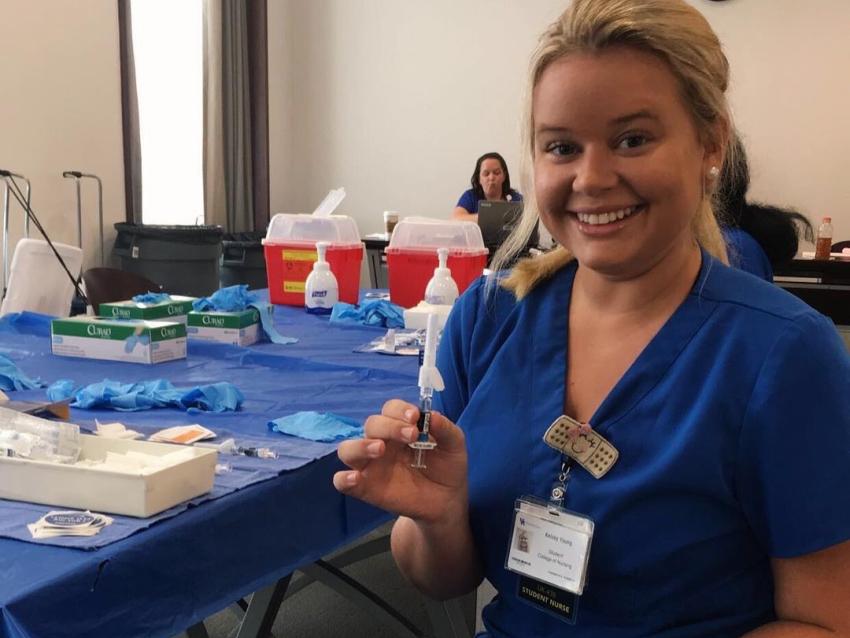
Senior nursing student shares her experience during COVID-19 outbreak
Below is a firsthand experience from a UK College of Nursing student during the COVID-19 outbreak.
Dear reader,
I am a senior nursing student at the University of Kentucky currently in my Public Health and Psych semester with plans to graduate in December 2020. I am writing this letter after just finding out that all classes have been moved to online for the duration of the semester, as have our clinical experiences and all exams.
While continuing my education online, I will also continue to work at my job back home as a Nurse Extern in the Emergency Department at an area hospital. I recognize that this is my time as a nurse extern and future nurse to step up, do my part, and use my knowledge to care for patients.
My perspective as a student is unique in that working in the ER also puts me on the frontline during this COVID-19 pandemic. Here is a look into my experience.
12-hour shifts look a little different now.
Screenings
We are screening every patient and visitor that enters the ER. The screening process consists of a series of questions: Have you been out of the country in the past 14 days? Have you been in contact with any individuals testing positive for COVID-19? Are you having any lower respiratory symptoms (cough, shortness of breath) or a fever?
If the patient answers yes to any of the questions, we give them a level one surgical mask and take them to a neutral pressurized quarantine zone. If the visitor answers yes, they are asked to leave and are not allowed to enter the hospital. Amid this crisis, Frankfort Regional, like many other hospitals, has had to strictly limit the number of visitors permitted to reduce the risk of exposure.
PPE
As healthcare professionals, we are especially challenged by the national supply shortage of personal protective equipment (PPE). The CDC has continued to alter our guidelines for wearing PPE to account for this shortage. For example, where N-95 masks (a respirator mask that prevents even the smallest of airborne particles from entering and is specifically fitted to your face) used to be the standard in several settings, we are now allowed to wear a level 3 mask (a surgical mask without a filter that is not fitted). We are also having to ration N-95 masks and are allowed to reuse level 3 masks despite them being designed for single use only. In some facilities, they have run out of all masks altogether and healthcare employees are being forced to cover their faces with bandanas as a last resort.
Testing
Another challenge? Testing.
When the crisis first hit, our department was flooded with patients with and without symptoms requesting to be tested after the media announced that anyone symptomatic or with potential exposure should be tested. The problem was that we didn’t have the tests. There was (and still remains) a national shortage of testing materials and laboratories (both state and private) that would accept specimens for testing. As providers, we can request tests but only if a patient meets narrow testing criteria. This means that not everyone who is symptomatic and requesting testing will be tested.
Thankfully, subsequent statements have been released informing the public that unless you are having respiratory issues, please remain at home and treat the symptoms. This helped in reducing the patient surge making the number of patients much more manageable and overall lowering the potential for exposures.
First positive case
As of the time I’m writing this, the facility where I work has had 1 positive coronavirus case. I am happy to say we are adhering to the appropriate CDC precautions to protect ourselves and patients. We began instituting our precautions with PPE, isolation, and neutral pressure areas long before the positive case hit the facility. And as of right now for our department, staffing is not an issue. Everyone has stepped up to pick up shifts and cover holes to support each other and provide excellent care to patients, which is something I am so proud of.
I have seen my coworkers exhibit bravery, dedication, and compassion despite adversity. Everyone throughout the facility has come together to work as a team: doctors and providers, nurses, respiratory therapists, environmental services, food services, lab and nurse techs, EMS, the administration and more. I understand that this has been happening all over the country from healthcare and public service workers. Thank them. They are our true heroes during this time. They have given up time away from families and are risking their health to step up and care for the public and patients.
Despite the number of cases rising in the United States, if we take the proper precautions regarding self-isolation, we will begin to see a decline in new cases and ultimately deaths. We need to take this risk seriously regardless of our age or health status. My plea as a nursing student is to please wash your hands, stay educated, stay home, and protect yourself and others. Do not take your health for granted, tell your loved ones you love them, and be kind—especially to our healthcare workers.
Thank you for reading,
Kelsey Young
